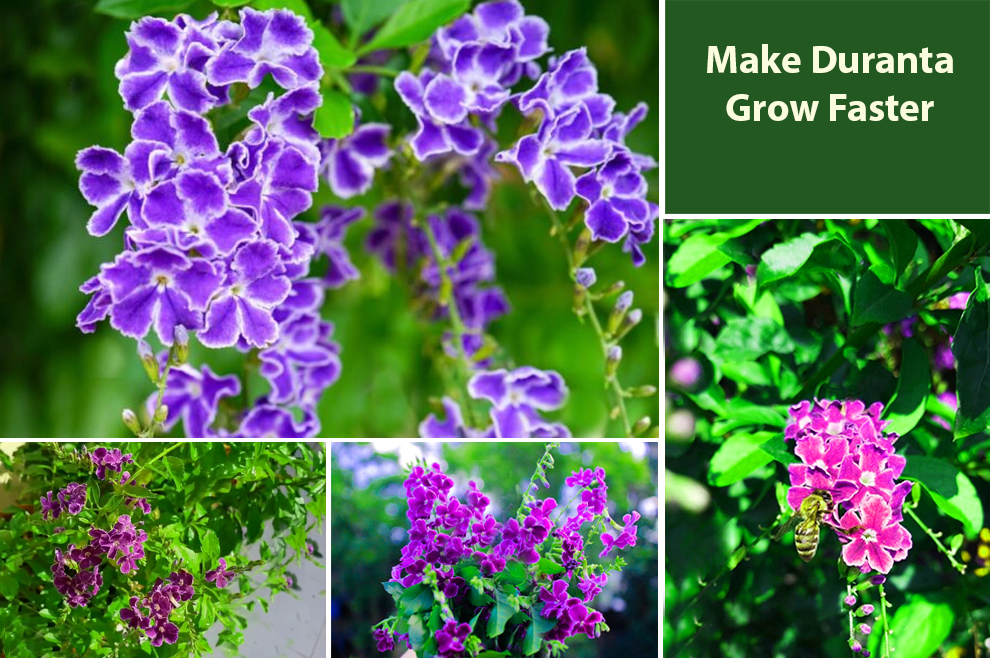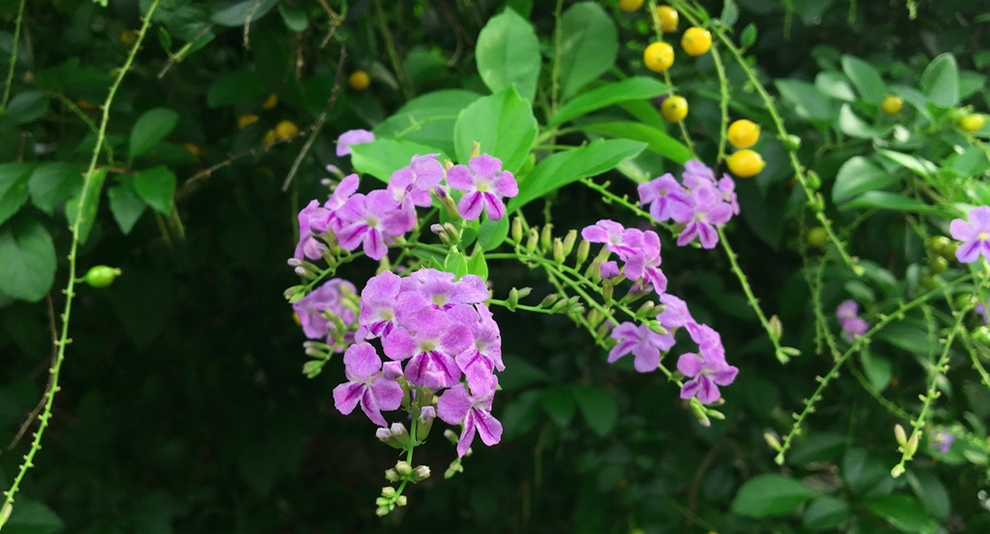How To Make Duranta Grow Faster – Healthier Better Blooms!
To make your Duranta plants grow at a faster rate, make sure you plant them in well-draining acidic soil. The climate zone should be toward the warmer side and a location that receives ample sun.

Durantas commonly known as the pigeon berries, sky flowers, or golden dew drops have captured the hearts of gardening enthusiasts. Landscapers all over the world adore the enchanting foliage and radiant blossoms of these trees.
If you are concerned with its steady growth, here’s how to make Duranta grow faster.
Providing them with the ideal growing conditions is the key to boosting the growth rate of Duranta.
To achieve the best growth and health for your Duranta, sunlight, water, and well-draining soil are the primary factors.
Then follows fertilization, mulching, pruning, optimal root health, growth supplements, support structures, and pest & disease control.
Promoting faster growth in Durantas holds significance for achieving optimal results, maximizing the inherent potential of plants, and enriching our environments, economies, and interactions with the natural world.
Duranta Plants – Loving Colorful Beauties!
Duranta also popularly known as the golden dew drops is a tropical evergreen plant appreciated for its lush attractive foliage and colorful flowers.
These plants flourish in full sunlight and well-draining soil; it thrives in warm climates with temperatures above 60°F (15°C).
Duranta can endure partial shade, wherein its flowering might decrease, and its growth habit may become more elongated.
Regular watering aids its establishment, while established plants tolerate drought.
Native to the Americas, Duranta finds its niche in coastal areas, open woodlands, and urban gardens, attracting pollinators.
Adaptable and versatile, Duranta shines as a hedge, shrub, or climbing vine. Its vibrant allure and adaptability make it a favored choice for landscaping in tropical and subtropical regions.
What Factors Make Duranta Grow Faster?
Many factors influence Duranta growth rate. While you can’t drastically speed up the natural growth rate of a plant, there are several steps you can take to help ensure your Duranta grows as quickly and healthily as possible.
Let’s look at how to make Duranta grow faster.
A. Does Duranta like acidic soil?
Duranta thrives in well-draining, fertile soil with a slightly acidic to neutral pH (6.0 to 7.0). Conduct a soil test to determine pH and nutrient levels. Adjust pH if necessary, using soil amendments.
Mix organic matter like compost or well-rotted manure into the soil. This improves soil structure, drainage, and nutrient content.
If the soil has poor drainage, amend it with coarse sand or perlite to enhance aeration and prevent waterlogging.
Incorporate a balanced, slow-release fertilizer before planting to provide essential nutrients. Follow recommended rates.
Regularly monitor and adjust soil pH as needed to ensure optimal nutrient availability. Use soil amendments like lime to raise pH or sulfur to lower pH.
Apply a layer of organic mulch. You can choose from wood chips, straw, or mulching sheets and put it around the base of the plant.
There are benefits of mulching such as moisture maintenance, soil temperature regulation, and getting rid of unwanted weed growth.
B. How much sun does a Duranta need?
Duranta plants thrive when provided with abundant sunlight, which typically means at least 6 to 8 hours of direct sunlight per day.
While Duranta prefers full sun, it can tolerate some degree of partial shade. If your garden or landscape has areas with dappled sunlight or a few hours of direct sun, Duranta may still thrive, albeit with slightly reduced growth and flowering.
In hotter climates, providing some afternoon shade can help protect Duranta from intense sun and heat stress.
In colder climates, it’s advisable to consider Duranta as an annual or to grow it in containers that can be brought indoors during the colder months.
If you’re in a climate where occasional light frosts occur, you can protect your Duranta by covering it with frost cloth or other protective materials overnight when frost is forecasted.
C. Temperature preferred by Duranta

Duranta plants thrive in warm and tropical climates. Temperature plays a crucial role in their growth and overall health.
They are well-suited for regions with warm temperatures. It prefers average daytime temperatures ranging between 70°F to 90°F (21°C to 32°C).
Exposure to frost can lead to damage or death of the plant. Temperatures below 50°F (10°C) can slow down growth and affect overall vitality.
If you’re growing Duranta in a borderline climate, protect during cold snaps or frosty nights using frost cloths, blankets, or other protective coverings.
In regions with fluctuating temperatures, consider planting Duranta in a location that benefits from a microclimate, such as against a sunny wall or near a heat-absorbing surface.
D. How much water does Duranta need?
Water Duranta deeply and consistently during hot and dry periods. Aim to keep the soil evenly moist during the active growing season.
Water early in the morning to minimize evaporation and give the plant ample time to absorb moisture before the heat of the day. During the initial planting phase, water more frequently to help the plant establish a strong root system.
Regularly check the soil moisture by inserting your finger into the soil to a depth of about 2 inches. If it feels dry at this depth, it’s time to water.
Ensure the soil has proper drainage to prevent water logging, which can lead to root rot. Implementing a drip irrigation system is an excellent way to provide consistent and targeted watering directly to the plant’s root zone.
Also, apply a layer of mulch around the base of the plant as it helps retain soil moisture, regulate temperature, and reduce water evaporation.
E. What is the best fertilizer for Duranta?
Duranta plants require a balanced mix of essential nutrients for optimal growth. Additionally, they need micronutrients like iron, manganese, zinc, and others.
Choose a well-balanced fertilizer with a ratio of 10-10-10 or similar, which provides equal amounts of N, P, and K, along with micronutrients.
As the growing season begins, apply a granular, slow-release fertilizer with a balanced N-P-K ratio. Around mid-summer, apply another round of fertilizer to sustain growth and flowering.
Duranta grown in containers may require more frequent feeding. Use a diluted liquid fertilizer every 4-6 weeks during the growing season.
Around mid-summer, apply another round of fertilizer to sustain growth and flowering. Periodically conduct a soil test to assess nutrient levels.
F. How do you prune a Duranta?
Proper pruning encourages branching, improves airflow, and enhances overall plant vitality. It also helps to remove dead or diseased growth, preventing potential issues and promoting new growth.
After planting, trim back any leggy or damaged growth to encourage branching. Conduct annual pruning during the late winter or early spring, before the growing season begins.
Remove about one-third of the older growth to make room for new shoots. Regularly remove spent flowers. Cut back overly long or straggly branches to a healthy bud or lateral branch as it promotes a bushier growth habit.
Occasionally thin out crowded or crossed branches to improve airflow and light penetration, reducing the risk of disease.
Begin training your Duranta plant when it’s young. Sometimes, growers struggle with how to make Duranta grow faster but forget this important step. So, pinch back the tips of branches to encourage lateral growth and bushiness.
If growing Duranta as a climber or vine, provide stakes or trellises for support and guide the plant’s growth in the desired direction.
To create a hedge, prune the sides of the plant to encourage denser growth. Gradually shape the top to your desired height.
Consistent pruning and training ensure that Duranta maintains its intended shape and structure as it grows.
G. What are the pests on Duranta?
Duranta plants can be susceptible to various pests and diseases. Recognizing these issues early is crucial for effective management.
Regularly inspect your Duranta plants for any signs of pest infestations or disease symptoms, such as discolored leaves, unusual growth patterns, or visible insects.
Remove and dispose of any fallen leaves or debris around the plant to eliminate potential breeding grounds for pests and pathogens. Proper pruning helps improve airflow and reduces conditions conducive to fungal growth.
Avoid overwatering, as excessive moisture can promote fungal diseases. Water at the base of the plant to keep foliage dry. Encourage beneficial insects like ladybugs and lacewings, which feed on common pests like aphids and whiteflies.
Use neem oil as a natural insecticide and fungicide or apply insecticidal soaps to control soft-bodied insects like aphids and whiteflies. If introducing new plants, isolate them for a period to ensure they’re not carrying pests or diseases.
H. Last But Not The Least – Regular Duranta Care
Consistent care is essential for ensuring sustained growth and the overall health of Duranta plants. By adhering to a regular Duranta’s care routine, you create an environment in which your plants can thrive and flourish.
Maintain a consistent watering schedule, keeping the soil evenly moist during the active growing season. Apply balanced fertilizers at the recommended times to provide essential nutrients for healthy growth and vibrant blooms.
Ensure your Duranta plants receive the right amount of sunlight based on their specific requirements. Monitor and adjust their placement if necessary.
Regularly prune and shape your Duranta. Monitor your plants for pests and diseases, and take prompt action if you notice any issues.
You can come across challenges like yellowing leaves, stunted growth, dropping leaves, wilting, discoloration, etc.
Consistently caring for your Duranta plants and promptly addressing any challenges that arise will contribute to their long-term growth, health, and beauty.
Regular observation and proactive management are key to a successful gardening experience.
